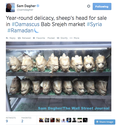-
About
- About Listly
- Community & Support
- Howto
- Chrome Extension
- Bookmarklet
- WordPress Plugin
- Listly Premium
- Privacy
- Terms
- DMCA Copyright
- © 2010-2025 Boomy Labs

 Martin Couzins
Martin Couzins
Listly by Martin Couzins
This is a set of articles I shared with Bath Spa University students on using social tools to develop stories.

As writers, we have a number of jobs. Putting words down on a page is only half of what goes on behind the scenes, right? There's also the editing, the research, the continuous coffee making and, of course, coming up with ideas.

Ben Rubin hasn't had much sleep over the last few days, and his legions of newly acquired fans have noticed. As the Guardian live-streamed an interview with Rubin, the founder and chief executive of hot new Silicon Valley app Meerkat, the most frequent comments from the audience of 51 people were along the lines of: "When was the last time Ben slept?"

There's no doubt that Twitter is a useful tool for news organizations. I see journalists use it throughout the day to find story ideas, share news and talk with one another, so I've long known that most journalists understand its purpose and appreciate its value.

In the first of our Polis LSE Summer School guest talks, the Wall Street Journal's EMEA social media editor Sarah Marshall explained how social media is helping journalists to make news more relevant to readers. Polis Summer School student Eleanor Hudson reports.

In the event, it was a false alarm. Jeffrey had simply flown out into the wide world to taste dung for the first time, a substance to which he has since become addicted. "I joined Twitter back in November because the people who do my website suggested it would be a good quick way of keeping in touch with readers," Pullman told the Telegraph.

Storify is a powerful tool for curating content from social media such as Twitter, Facebook, YouTube, Flickr, Instagram and SoundCloud. The platform has come a long way since it launched in private beta in 2010, and used by news outlets to cover everything from the Arab Spring to the Oscar Pistorius trial.
